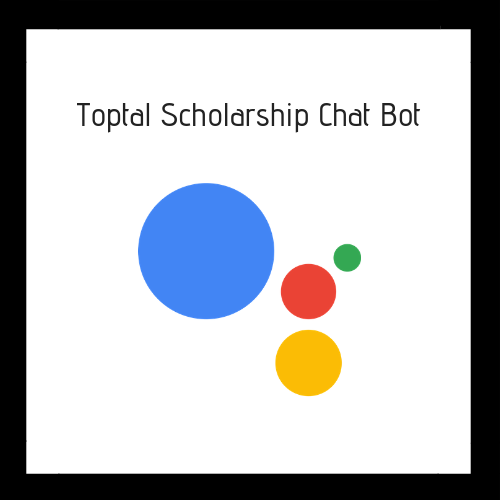Rethinking Education for the new Knowledge Economy
Table of Contents
- What is my vision to change the world?
- Why a 21CU?
- Who will benefit from 21CU and How?
-
How do we go about building 21CU?
– Foundational frameworks of 21CU
– Story so far - Impact Stories
- Where to? : Roadmap to the future
- How can Toptal help?
- About Me
- References and External Links
What is my vision to change the world?
Vision: 100% 21st century skills literacy in India
Mission: To build a 21st century university for Indian Youth that equips them with 21st century skills and inspires them to become life-long learners, productive citizens and leaders.
Why a 21CU?
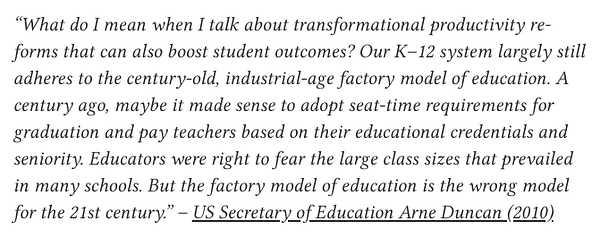
During the second Industrial Revolution, majority of students were educated to prepare for work on farms or in factories. The Factory Model of education was designed to meet the societal needs of the industrial age. Emphasis was on one to many information dissemination to age-based cohorts of students and equipping them with the basic skills required to work in the factories.
Post the second industrial revolution, happened the internet. Information consumption, creation and dissemination became decentralised. But our educational systems continue to operate on the factory model, incapable of leveraging this superpower that came with the internet.
To cope up with the pace of the 21st century, it is essential that we move from a one to many, everyone-goes-at-the-same-pace learning model to many to many, self-paced learning model.
The current model where students complete their entire education, enter the workforce and then work for the rest of their life is not serving the needs and demands of today.

What’s required to keep up with the 21st century is life long learning.

3Rs + 4Cs
To flourish in the 21st century, we need to cultivate knowledge workers who possess 21st century skills.
Our traditional education systems focussed on imparting the students with 3Rs — Reading, Writing and Arithmetic.
The 21st century skills go beyond these 3Rs to include the 4Cs — Communication, Collaboration, Critical thinking and Creativity.
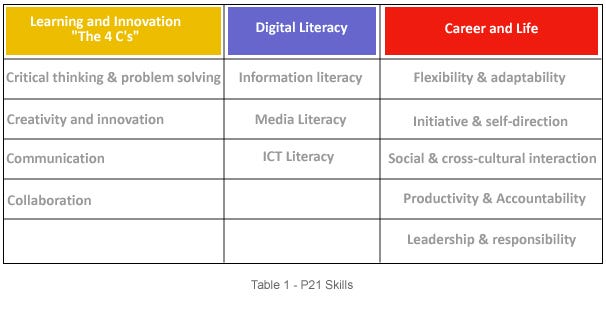
It is only through excellence in these key skills can talent thrive in the 21st century and become productive individuals.
Knowledge and practice of 21st century skills and lifelong learning is now a growing economic necessity. The inadequacy of our traditional educational systems to facilitate these is exactly why we need a 21CU.
Why India?
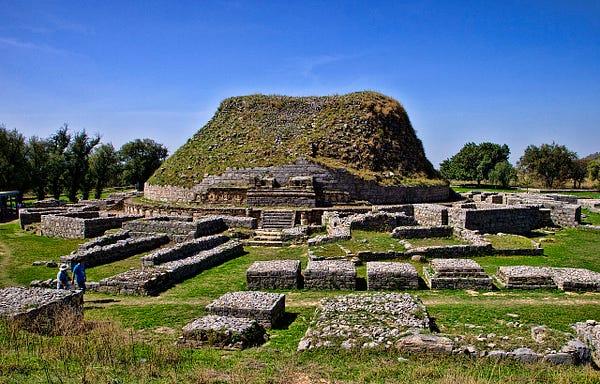
Akin to the Thakshashila, that was once known to be the seat of pristine knowledge, where learners from across the world arrived seeking knowledge, we aspire to root our 21CU in India and be known as a centre for global learning and talent development.
Who will benefit from 21CU and How?

How do we go about building 21CU?
This section covers two parts:
- Foundational frameworks or beliefs in building 21CU
- Story so far
Foundational frameworks of 21CU
The following findings from Sugata Mitra’s research called ‘Hole in the Wall’ and ‘School in the Cloud’ form the basic pillars of our university’s pedagogy.

Our 21CU focuses on:
- Learning to learn on one’s own (Meta learning)
- Learning by doing ( relevant and practical, not just passive and theoretical)
- Learning through collaboration and by helping others learn (peer-learning)
Given the power of the internet, we are convinced that a 21st century university should predominantly operate online with physical interactions and collaborations whenever needed.
Our 21CU doesn’t have classrooms, teachers or text books. Instead, we facilitate frameworks for learning, thriving learning environments and unconditional, unfaltering encouragement to learn.
The deck below captures the credo, frameworks of our 21CU and the research material that has led us to these frameworks.
https://docs.google.com/presentation/d/1VpAnDu0Rx0bP8HVlSxcK6kUoQw_Yxnrp_Vm9Zj2M–w/edit?usp=sharing
Story so far
We began running several experiments in shaping our efforts towards building a 21CU in 2017 and now have gotten to a point of some shape and maturity in terms of execution.
Our 21CU runs online learning programs where learners learn by doing, collaborating and contributing to the society. Our model involves working with learners in self-organising learning environments, equipping them with 21C skills and inch closer to their aspirations.
Creation of public goods as part of independent learning is at the heart of our learning programs. This means that every activity in our program involves the learners creating assets that benefit the society and are provided without profit to the public.

Reindexing Aspirations
As a university, one of our key objectives in addition to facilitating 21C learning programs is to reindex aspirations of our learners through exposure.
We believe that aspirations of individuals have a direct correlation with their exposure and by increasing the amount of exposure the individual receive, we encourage them in aspiring for bigger goals and outcomes.
One of the ways in which we do this is by encouraging our learners to pursue professional development opportunities and scholarships. (Learners’ aspiration is also what we latch on to sustain their motivation to learn). In addition to this, we also set up scholarships and exposure programs for our learners to leverage.
We have 3 types of learning programs:
- Foundation Learning Program: For picking up 21st century skills (2 weeks)
- Flagship Learning Program: For equipping learners to work towards their long term goals (4 weeks)
- Advanced Learning Program: To shape up leadership talent and equip them with world-class exposure
Currently Active Learning Programs
We ran one cohort each of our Foundation Learning Program and Flagship Learning Program, designed to equip female engineering students and early alumni to leverage professional development scholarships and opportunities.
Our theme revolved around opportunities for women in tech for multiple reasons:
- Engineering students are familiar with basic ICT skills at the very least, which makes it easier to build 21C skills on top of their foundation.
- We deeply care about inclusion and equal participation from all quarters is important for us. We decided to work with women first to provide them with initial comfort and head-start before making our communities open to all.
- Strengthening the sisterhood within our learning communities and ensuring a safe space for women and other minorities in our learning communities became easier since we got the dedicated time and engagement to build out strong foundations for women, with women.
Learning Program Structure
The overarching theme for our learning programs is to help our learners learn on their own and pick up skills through creation of public goods.
In our Flagship Program called the Women in Tech Learning Program (WIT), we engaged with 23 learners for 4 weeks. Entirely online, relying on digital tools such as email, telegram, wiki and so on.
The 4 weeks of the program were divided into 4 major themes:
- Discover — learning to discover opportunities
- Build — building a tech project
- Connect — discovering people and interviewing them
- Apply — learning to critically think and apply to opportunities
Every week, the participants of WIT Cohort 1 completed theme specific activities for that particular week. These activities were designed so they learn to figure out things on their own and also build assets in the process. In addition to completing activities, they were expected to document their learning from the week’s exercises in Weekly learning blogs called as TWTWs (The Week That Was). At the start of the program, each learner selects a coach for 1–1 coaching throughout the program and communicate with the coach every week in seeking guidance, feedback and reviews. The role of the coach in our learning programs is primarily that of a granny, encouraging them to learn and attempt the activities.
Below is a snapshot of the activities they completed in just 4 weeks.

Pedagogy
Activity-based collaborative learning is central to our 21C pedagogy.
Every week, we set expectations for the outcomes the learners would create and attempt to clearly articulate what the learner will be building, learning and why it was important. We provided context in abundance as against specific instructions on how the learner must complete the activities. Once we set the context and sealed expected outcomes, the learner was left to paint her own picture of how she wished to go about the activity. Along her way, she had her peers and coaches to guide her and encourage her till she saw it through to completion.
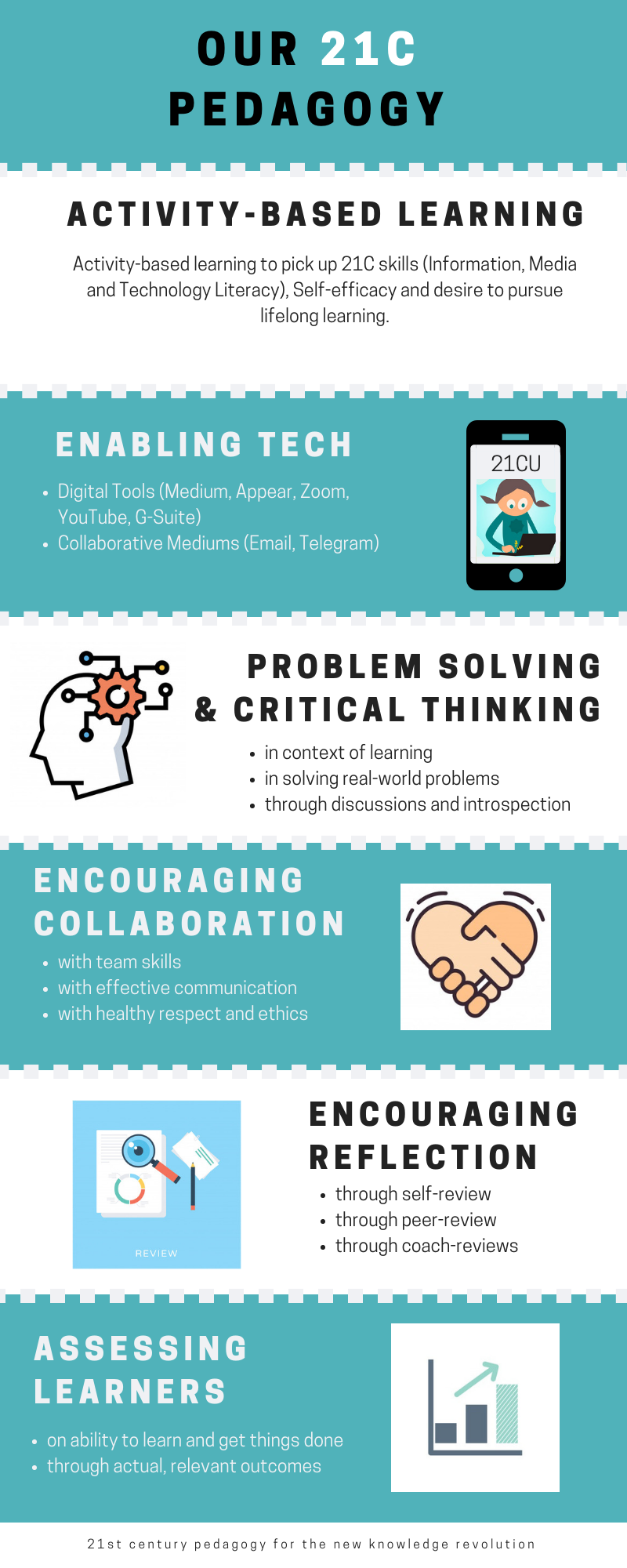
Outcome
We noticed that by clearly setting expectations and objectives and providing relentless encouragement, our learners performed exceptionally well and even exceeded expectations.
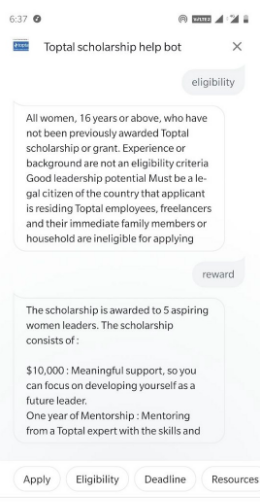
In just a week, our learners made their first open-source contribution, built a chat bot, connected with their role-models and interviewed them, learned to set bigger aspirations, created their learning plan and critically evaluate everything in between.
In fact, we had one of our learners discover the Toptal scholarship and create a wiki and chat-bot that provides information about the scholarship as part of the program.
See all that our learners accomplished in the program here:
WITx, Our Foundation Learning Program
Upon completing our WIT Learning Program, our girls moved on to demonstrating leadership by leading our foundation learning program (called WITx) in their respective campus communities.
This program had 82 participants and was 2 weeks long. This time, we had our facilitator who would set weekly expectations and our previous WIT participants as guides, providing relentless encouragement. And of-course, the learners had each other throughout their learning journey.
We were again taken aback by the kind of performance they exhibited. The program successfully concluded with a 75% completion rate.
Impact Stories
Sharing an email from one of our WITx Foundation Learning Programs.

View more learning program experience sharing videos and testimonials here:
Where to? : Roadmap to the future
Where do we want to get to? — 100% 21C skills literacy in India
By when do we hope to get here? — This project honestly appears to be a lifetime project. If we look at the literacy landscape of India, we note that the literacy rate in various Indian states vary extensively. In states where the people have not even attained the 3Rs of basic education, we cannot at this moment think of introducing 21C skills.
Where do we start? —We work with the Indian youth as our primary audience. If we equip at-least one member of each family with 21C skills, we rapidly improve the productivity of the individual as well as his/her household and local community.
By 2020, India will be the youngest country with an average age of 29. The time is ripe in working with Indian youth to improve their professional outcomes.
We hope to equip 500M Indian youth with 21C skills by 2025.
Amongst Indian Youth, we begin working with STEM/Engineering students given that they are already proficient in basic ICT skills. Build 21C skills on top of this foundation has been found to be easier in our experience so far as well.
3 year plan (by 2022)
In 3 years, we aspire to have our learning programs integrated with the Indian Engineering Colleges. All students enrolling in the engineering colleges take up our foundation program. We’re talking about an estimate of 1.5 million engineering students every year.
1 year plan (2019)
As discussed earlier, we hope to first consolidate the female learner audience before opening up our communities to all.
Right now, we have a foundation learning program (WITx) that equips with 100 learners in 2 weeks. This year, in 2019, we aspire to scale our learning programs to equip 1000 female learners/month, leading to 12,000 learners a year.
As part of our Cohort 1 learning programs, we also set up 10 scholarships for top performers of our programs to attend the Grace Hopper Celebration India (GHCI), Asia’s largest women in tech conference. This year, we wish to set up 100 GHCI student scholarships in partnership with the industry.
Additionally this year, we hope to pilot one version of our Advanced Learning Programs to shape up leadership talent and equip them with world-class exposure to reindex their aspirations. We’re hoping to set up a Silicon Valley exposure program for 5 selected students of this learning program to meet strong female leaders and develop a public good project.
Objective for Y1: Strengthen the sisterhood within our community, create a well-oiled learning program engine and scale our exposure programs
Quarterly plans (2019)
- Q1 (Jan— Mar) : Design and run a cohort for our Advanced Learning Program
- Q2 (Apr — Jun ) : Design a Silicon Valley Exposure Trip for learners (Reindexing aspirations)
- Q3 (July — Sep) : WIT Cohort 2, Piloting a mixed learning program
- Q4 (Oct — Dec) : WIT Learning Program Consolidation, Physical meet-up at GHCI 2018
- Starting Jan 2019, we hope to run one foundational learning program every month and also work towards exploring partnerships with 100 orgs in providing GHCI scholarships.
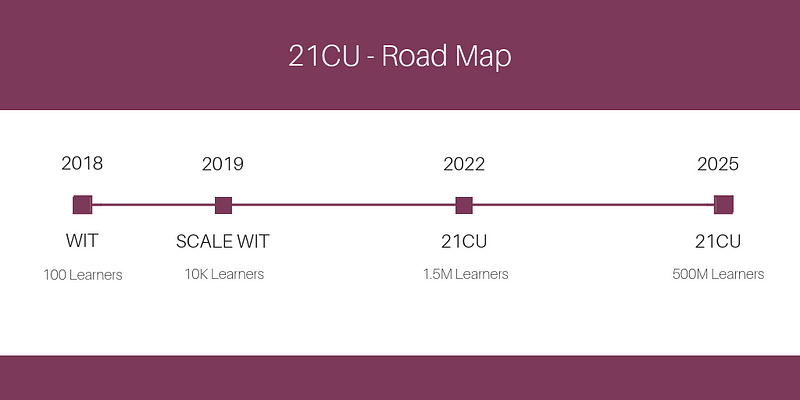
How can Toptal help?
I’ve identified the following areas where support and mentorship from Toptal would be of help:
- Financial Resources: The scholarship amount of 10K USD is just enough for me to sustain myself and work full-time on building 21CU for 2 years.
- Polishing our learning programs: Although I believe we’ve done some good work, designing a great learning program for all requires deeper thinking and execution. Working with an educationist in tightening our Foundation learning programs and designing a good quality Advanced learning program would help.
- Guidance on scaling operations: As we gear up towards scaling our operations aggressively, guidance from someone experienced in scaling online ventures or remote work would be of help. We currently rely on free and open source softwares for collaboration and scaling might mean revamping our existing systems or even setting up an independent learning platform. Guidance on tech infrastructure to support scale would be useful.
- Partnerships with organisations: Since we’re exploring partnerships with organisations to provide exposure scholarships, industry connects and referrals for organisations we may collaborate with would really help.
- Leadership Training: As I work my leadership capabilities and evolve as a champion of 21st Century Education, I’d absolutely appreciate help in chiseling my capabilities. Exposure to strong female leaders who I can learn from would be fantastic!
- Constant Encouragement: Because we can’t get enough of it!
About Me
I identify myself as Leader, Community Champion, Tech Evangelist.

Been curating and leading student and women in tech communities
for 3+ years now.
I deeply care about education, inclusion and equal opportunities for all.
Read more about me from my website: aryamurali.com
My Aspiration?
To attend graduate school in a world-class institution (Read Stanford or Oxford) and build something that adds value to the society and stands the test of time.
I’ve picked up a lot of interest in Education and Leadership. I see myself pursue further formal education in this space to structure my thinking.
21CU fits right in to my interest space and is a project that would add immense value to the society.
I’ve already started chipping away on this and would continue to work on it post graduate education as well. For building 21CU is me putting my knowledge to use and also learning further through the process.
Building 21CU is me shouldering leadership.
https://media.giphy.com/media/26BkNrLcfeUT61fyg/giphy.gif
What inspires me to take this leap?

I feel compelled to work on this. To build 21CU.
Who’s with me?
SKG, and 100 contributors thus far.
SKG is my co-founder and partner in crime. We also have 100 learners from our learning programs contributing towards our efforts.
How I believe I can accomplish my goals?
Put my head down and work. I’ve always known myself as someone who aspires to do good work, exciting work. And every time I’ve come across something compelling enough to work on, I’ve gone all in. I feel 21CU is one of those things.
Additionally, the early traction from our learning programs helped in strengthening belief. With effort and right guidance, I’m sure we’ll get there.

References and External Links
- Research Materials
- WIT Learning Program Website
- WIT Program Outcomes and WITx Program Outcomes
- My Personal Website
- My LinkedIn
- Meet SKG — sijokuruvilla.in
This blog post has been put together as part of my application to the Toptal Scholarships for Women to Develop as Leaders.
If you wish to get in touch with me, feel free to write to me at hello@aryamurali.com or tweet to me @aryacmurali.


